#188: Leotia lubrica, Jelly Babies
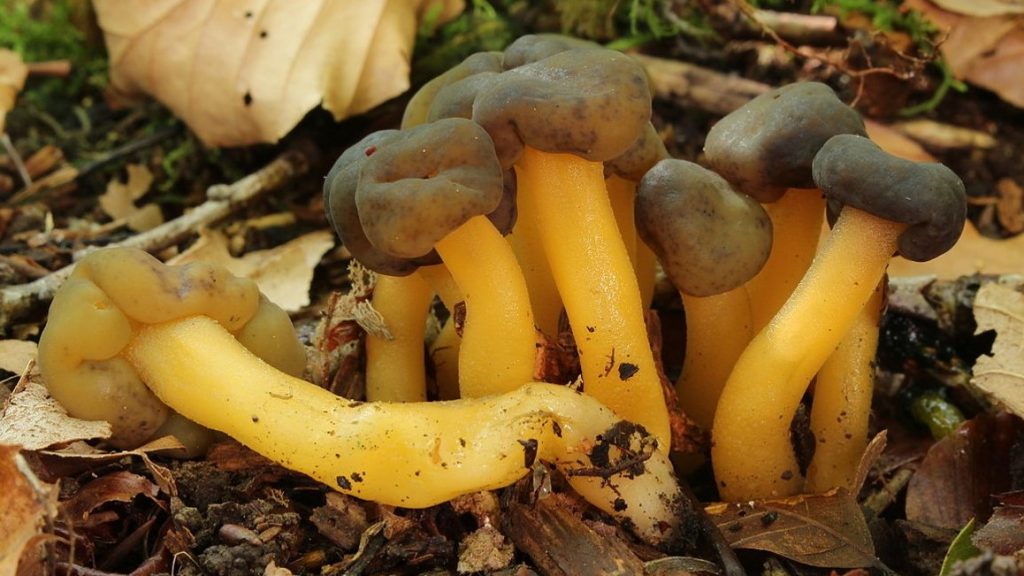
Leotia lubrica has a yellow to brown cap and a yellow stipe. Its gelatinous texture earned it the common name “Jelly Babies.” Photo by H. Krisp [CC BY 3.0], via Wikimedia Commons (cropped).
Description
The cap of L. lubrica grows 1-4cm across and is basically shaped like the top part of a mushroom cloud: irregularly circular, lumpy or lobed at times, and curved down from the center with the margin rolled under even more. The mushroom cloud image usually calls to mind an agaric mushroom, but Jelly Babies are ascomycetes and do not produce gills. Instead, both surfaces of the cap are smooth in between the irregular wrinkles and lobes. The upper surface of the cap, which produces the spores, is yellow to light brown and sticky to slimy when the mushrooms are fresh. Underneath, the cap is off-white and smooth; however, these features are not very useful because they are usually hidden by the highly inrolled cap margin.1–4
The stipe of a Jelly Baby is not very interesting. It grows 2-8cm tall, making the cap look small in comparison. The stipe is fairly thin but can grow up to 1cm in width. Most Jelly Baby stipes remain roughly the same width for their entire length. Some may be thicker in places because they curve (which often happens when the fungi grow in tight clusters) or because they are slightly flattened or furrowed. The stipe is often paler than the cap, although it can be the same color as the cap (but no darker). The surface of the stipe is covered in tiny, white scales and can be slimy when fresh. If you slice the stipe open, you will find it is composed of gelatinous cells.1–4
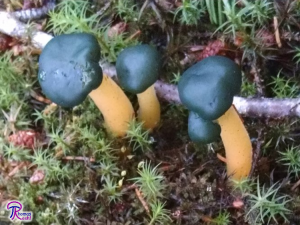
Jelly Babies and their relatives, including this L. viscosa, frequently fruit in moss. L. viscosa is differentiated by its dark green cap.
Ecology
Jelly Babies grow on the ground or on well-rotted wood in both hardwood and conifer forests in North America and Europe. They are saprobic, spending their time decomposing organic matter in the soil. The mushrooms are common and appear from late Spring through fall or over winter in warmer climates such as the American West Coast. Jelly Babies often choose to grow in mosses and commonly clump together in groups or tight clusters.1–4
L. lubrica is sometimes listed as edible in field guides, but it is not a very appetizing fungus. Its small size, slimy texture, and lack of a distinctive taste or odor mean you’ll probably eat this mushroom only once just to say you’ve tried it.2,4
Similar Species
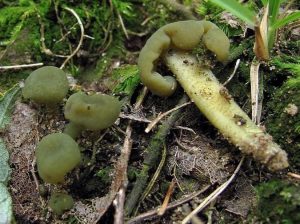
There is some speculation that L. atrovirens (pictured) is not a separate species but rather a mildly parasitized form of L. lubrica. Photo by Bob (Bobzimmer) [CC BY-SA 3.0], via Wikimedia Commons (cropped).
Taxonomy
The DNA of L. lubrica has not been thoroughly studied. The most recent results indicate that it is not monophyletic and neither are L. viscosa and L. atrovirens.1 These three species also overlap morphologically and many intermediate forms can be found.6 Apparently Leotia is due for a major shake-up sometime in the near future.1 It is impossible to say whether the result will be the three species are combined into one morphologically diverse species or they will be divided into numerous morphologically indistinguishable species.
Even before DNA analysis, some mycologists were not convinced that the species were divided up correctly. Various authors have suggested that L. atrovirens is just a parasitized form of L. lubrica. Presumably, the parasite is another fungus that somehow turns the mushroom greenish.1 However, in the absence of detailed genetic data, this idea is just speculative.
| Kingdom | Fungi |
| Division | Ascomycota |
| Subdivision | Pezizomycotina |
| Class | Leotiomycetes |
| Subclass | Leotiomycetidae |
| Order | Helotiales |
| Family | Leotiaceae |
| Genus | Leotia |
| Species | Leotia lubrica (Scop.) Pers.7 Leotia viscosa Fr.8 Leotia atrovirens Pers.9 |
This post does not contain enough information to positively identify any mushroom. When collecting for the table, always use a local field guide to identify your mushrooms down to species. If you need a quality, free field guide to North American mushrooms, I recommend Michael Kuo’s MushroomExpert.com. Remember: when in doubt, throw it out!
See Further:
http://www.mushroomexpert.com/leotia_lubrica.html
http://www.first-nature.com/fungi/leotia-lubrica.php
http://www.mykoweb.com/CAF/species/Leotia_lubrica.html
http://www.messiah.edu/Oakes/fungi_on_wood/club%20and%20coral/species%20pages/Leotia%20lubrica.htm
Citations
- Kuo, M. Leotia lubrica. MushroomExpert.Com (2012). Available at: http://www.mushroomexpert.com/leotia_lubrica.html. (Accessed: 19th May 2017)
- O’Reilly, P. Leotia lubrica (Scop.) Pers. – Jellybaby. First Nature Available at: http://www.first-nature.com/fungi/leotia-lubrica.php. (Accessed: 19th May 2017)
- Emberger, G. Leotia lubrica. Fungi Growing on Wood (2008). Available at: http://www.messiah.edu/Oakes/fungi_on_wood/club%20and%20coral/species%20pages/Leotia%20lubrica.htm. (Accessed: 19th May 2017)
- Wood, M. & Stevens, F. California Fungi—Leotia lubrica. The Fungi of California Available at: http://www.mykoweb.com/CAF/species/Leotia_lubrica.html. (Accessed: 19th May 2017)
- Wood, M. & Stevens, F. California Fungi—Leotia viscosa. The Fungi of California Available at: http://www.mykoweb.com/CAF/species/Leotia_viscosa.html. (Accessed: 19th May 2017)
- Emberger, G. Leotia atrovirens. Fungi Growing on Wood (2008). Available at: http://www.messiah.edu/oakes/fungi_on_wood/club%20and%20coral/species%20pages/Leotia%20atrovirens.htm. (Accessed: 19th May 2017)
- Leotia lubrica. Mycobank Available at: http://www.mycobank.org/Biolomics.aspx?Table=Mycobank&Rec=122042&Fields=All. (Accessed: 19th May 2017)
- Leotia viscosa. Mycobank Available at: http://www.mycobank.org/BioloMICS.aspx?TableKey=14682616000000067&Rec=232454&Fields=All. (Accessed: 19th May 2017)
- Leotia atrovirens. Mycobank Available at: http://www.mycobank.org/BioloMICS.aspx?TableKey=14682616000000067&Rec=237017&Fields=All. (Accessed: 19th May 2017)

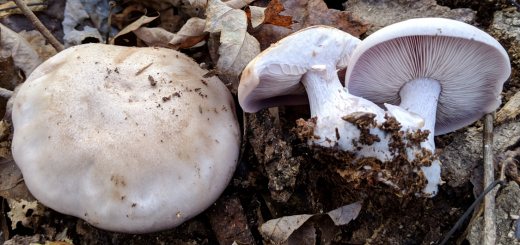






![#011: Characteristics of Kingdom Fungi [Archived]](https://www.fungusfactfriday.com/wp-content/themes/hueman/assets/front/img/thumb-small-empty.png)

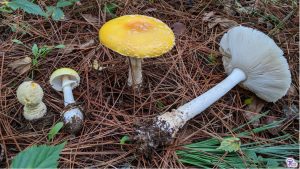
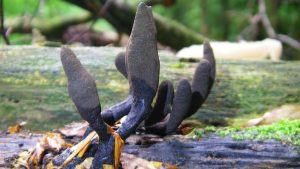
1 Response
[…] a little more distinctive thanks to its smooth cap. You might confuse it with Leotia lubrica (FFF#188), although that species appears later in the year, has a slimy or gelatinous texture, and a cap […]